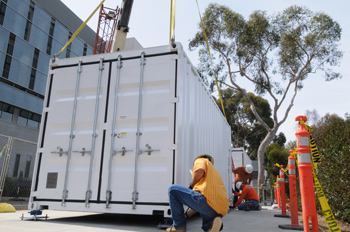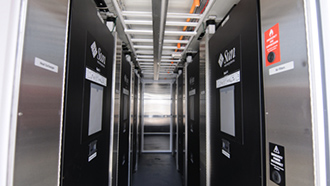UC San Diego has an article about their new Energy Efficient Computing project, GreenLight.
UC San Diego’s GreenLight Project to Improve Energy Efficiency of Computing
July 28, 2008
By Doug Ramsey
The information technology industry consumes as much energy and has roughly the same carbon “footprint” as the airline industry. Now scientists and engineers at the University of California, San Diego are building an instrument to test the energy efficiency of computing systems under real-world conditions – with the ultimate goal of getting computer designers and users in the scientific community to re-think the way they do their jobs.

This Sun Modular Datacenter deployed on the UC San Diego campus will be instrumented for the GreenLight project to offer full-scale processing and storage in order to test how to make computing more energy-efficient.
The National Science Foundation will provide $2 million over three years from its Major Research Instrumentation program for UC San Diego’s GreenLight project. An additional $600,000 in matching funds will come from the UCSD division of the California Institute for Telecommunications and Information Technology (Calit2) and the university’s Administrative Computing and Telecommunications (ACT) group.
The GreenLight project gets its name from its plan to connect scientists and their labs to more energy-efficient ‘green’ computer processing and storage systems using photonics – light over optical fiber.
The goal of GreenLight is to under computational performance per watt.
The GreenLight Instrument will enable an experienced team of computer-science researchers to make deep and quantitative explorations in advanced computer technologies, including graphics processors, solid-state disks, photonic networking, and field-programmable gate arrays (FPGAs). Jacobs School of Engineering computer science professor Rajesh Gupta and his team will explore alternative computing fabrics from array processors to custom FPGAs and their respective models of computation to devise architectural strategies for efficient computing systems.
“Computing today is characterized by a very large variation in the amount of effective work delivered per watt, depending upon the choice of the architecture and organization of functional blocks,” said Gupta. “The project seeks to discover fundamental limits of computing efficiency and device organizing principles that will enable future system builders to architect machines that are orders-of-magnitude more efficient modern-day machines, from embedded systems to high-performance supercomputers.”
The computing and systems research will yield new quantitative data to support engineering judgments on comparative “computational work per watt” across full-scale applications running on full-scale computing platforms.
This is a big win for Sun Microsystems and their containers.
“Using the Sun Modular Datacenter as a core technology and making all measurements available as open data will form a unique, Internet-accessible resource that will have a dramatic impact on academic, government and private-sector computing,” said Emil J. Sarpa, Director of External Research at Sun Microsystems, Inc. “By placing experimental hardware configurations alongside traditional rack-mounted servers and then running a variety of computational loads on this infrastructure, GreenLight will enable a new level of insight and inference about real power consumption and energy savings.”
According to DeFanti, the project decided to build the GreenLight Instrument around the Sun Modular Datacenter because, “it’s the fastest way to construct a controlled experimental facility for energy research purposes.” The modular structure also means the GreenLight Instrument can be cloned – unlike bricks-and-mortar computer rooms that cannot be ordered through purchasing.

Interior of the Sun Modular Datacenter prior to deployment of up to 280 servers and other equipment that will turn the shipping container into the GreenLight Instrument.
And to make things a bit sexy, they plan on using a virtual environment to visualize inside the containers..
Rather than give scientists physical access to the GreenLight Instrument, OptIPortal tiled display systems will serve as visual termination points – allowing researchers to “see” inside the instrument. Users will also be able to query and visualize all sensor data in real time and correlate it interactively and collaboratively in this immersive, multi-user environment.
Once a virtual environment of the system has been created, scientists will be able to walk into a 360-degree virtual reality version in Calit2’s StarCAVE. Users will be able to zoom into the racks of clusters as well as see and hear the power and heat, from whole clusters of computers down to the smallest instrumented components, such as computer processing and graphics processing chips.